Front offset collision Saturn SL2 & GMC Sonoma pickup
|
Half an hour after leaving Pittsburgh, Pennsylvania for home in New
Hampshire, our SL2 collided with a pickup truck that attempted to make
a left turn in front of us. Our speed was 35-40 MPH, the truck's
15-25. This offered us the rare opportunity to exercise airbags in both
vehicles. My wife was driving, and she managed to react with a right
veer, but there really wasn't enough time to do much more than close
our eyes. |
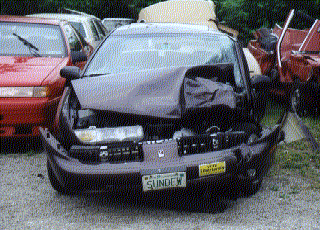 |
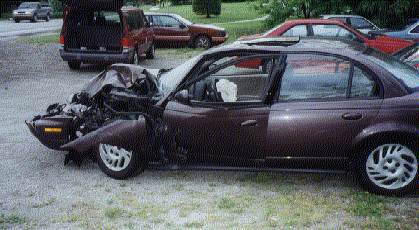
|
Our left front contacted the left
front of the truck and the two drivers saw each other's
terror. It looks like the truck's bumper overrode
ours and the engine compartment dissipated most of the impact energy.
|
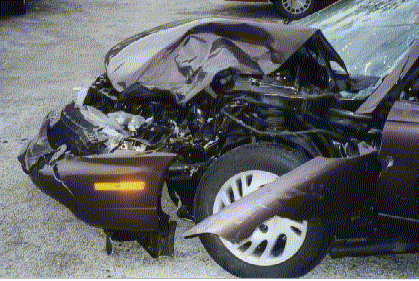 |
|
The driver's side front door crumpled and window shattered. The
windshield pillar was forced up, transmitting force to the roof, and
buckling both. The rear seat backs were forced forward in the center.
They attach to the car on a pair of pins coupled to the frame by a
piece of sheet metal. I wasn't able to tell if the deformation was
due to frame damage or from the pressure of decelerating luggage in
the trunk. I reached into the crumpled door and felt the side brace
was intact, I think the front end where the pipe is trimmed down to
a half round bent outward, opening up the window slot.
|
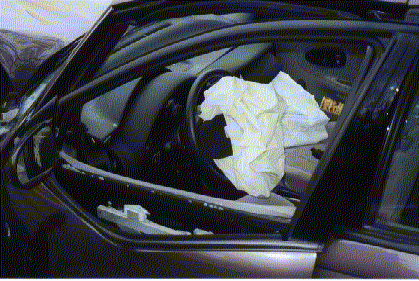 |
All in all good, but not perfect, similarities to the Insurance Institute for
Highway Safety's frontal offset crash test. The lateral forces
must have been comparable to a lowish speed side impact crash, but
without the inward side deformations. From what I see on the Web, the
Saturn's weight is 2269 lb (plus some 500 lb for occupants and
luggage), the Sonoma 3536 lb (plus driver). I'll try to come up with
estimates for equivalent immovable barrier velocities.
Damage to the truck was severe. The driver was able to back away
from the Saturn, but I think he dragged one of the front wheels.
I never had time for a close look at the truck.
Paula was the first to talk, saying "Smoke!".
As I sniffed and realized it must be from the airbags, Paula continued
with "Get Hannah out!"
That seemed to make a lot more sense than launching into a
description of airbag chemistry and physics (once an engineer, always
an engineer). My door opened fine, and as I walked around the car to
where Hannah had been sleeping in the rear seat I decided my body was
reasonably functional. Hannah was crying but moving her legs and
complaining about her hip (and everything else) so I figured her spine
was in good shape. Her door opened enough to get her out and I
carried her to the stone base of a large sign, sat her down, and tried
to comfort her.
By then, occupants from the truck and other nearby vehicles were
milling around, one was a nurse. Everyone seemed to have cellular
phones. An ambulance was on the scene. I thought it just stumbled
upon the scene and was available to help, but it was transporting a
dialysis patient and left when the first responding ambulance arrived.
Paula's door was wedged shut. She managed to slide over to and out
of the passenger door and was helped over to the sign base.
All three of us in the Saturn were admitted to the hospital, Xrayed
multiple times, treated, and released. Paula has a
sprained right knee and is on crutches. Late flash - the hospital called
saying the radiologist doesn't like the look of her fibula. That's more
in line with her thinking, as she already had made an appointment with a
local orthopedic surgeon. Still, not bad, since she was expecting the
truck's engine to replace her lap. Later flash - a closer look and new
Xrays disclose a fracture at the top of the fibula, i.e. a Broken Leg.
She's in a leg splint to immobilize her knee. She can't drive with that on,
perhaps I don't need to buy a new car right away! Latest flash - add a
torn ligament to the knee and a prescription for a MRI scan. MRI shows
a different ligament than expected was torn, but just one. Surgery will
be needed after everything else heals.
I was in the front passenger seat and wasn't paying close attention
to the road. I have bruises on both knees, left elbow and right
chest. A bruise over my right bicep is the major visual "feature".
It's ugly, but doesn't hurt. Hannah has a bruised hip and head.
We all have abrasions from seat belts. I think my right arm was
between the airbag and eyeglass case in my shirt's right pocket, as that
best explains the chest and arm bruises. So yes, even with seat
belts, airbags are useful during a collision. None of us have neck
injuries.
We were in Pittsburgh for my mother-in-law's funeral. Fortunately,
the funeral home won't be getting repeat business this week! I phoned
my sister-in-law at the hotel and she and her brother came down to get
us, the luggage, and the license plates. I forgot to get my Darwin fish off the trunk lid. Oh
well, compared to the rest of the week, it's a minor loss.
My sister-in-law reserved the last room in the hotel for us (smoking,
yuck), and we flew back to New Hampshire the next day. My
brother-in-law saved a Saturn medallion from the car, so I brought it
to the Saturn dealership to show I needed a new car. I got a better
reaction at the Toyota dealership when I put it down and said the rest
of the car is in Pennsylvania.
I called an 800 number on Saturday to report the crash and they
said an insurance adjuster would contact us within two business days.
They missed that promise, watch this space for developments. Finally
heard from the adjuster on the third day in the afternoon. It's on
the answering machine as I was chaufeurring the rest of the family around
Concord and Boscawen. At least she left a phone number. Things are
finally on track. The adjuster reported the car was totaled, and we
have a settlement for that. We haven't submitted medical bills yet.
One final note. When we got home (sweet home), one the pieces of
mail was a first birthday card from the Saturn dealership "Think of all
the fun things you've done in the past year..." "...and how your
Saturn was there to share them with you. Congratulations on your
Saturn's first birthday." I bought the car on May 14th - it was totaled
one year, zero months, zero days, and a few hours later. Indeed, its
first year went fine. Let's hope its replacement, another Saturn, has
a better second year.
Postscript - Car crash physics
While my career has centered around computer operating system development,
physics was my favorite high school course. No other subject better
explains how the world behaves. The two vehicles were moving at
different speeds and had different weights, let's try to convert this
collision into something comparable to crash test results.
First, there's a lot of uncertainty in all the following numbers. Many are
accurate to only one place. Second, I'm leaving out some of the math.
You may be able to recreate everything without making too many
assumptions, but I may have left out a few items.
The police report listed the pickup as traveling at 25 MPH and our Saturn
at 35. the pickup was making a 45 degree left turn, quite doable at 25 MPH,
but it was clear at the crash scene we pushed it backwards, and 25 just
seems too fast. Before I saw the police reports, I assumed 5-15, but 20
MPH seems to fit everything pretty well. Our 35 MPH seems like a good
estimate.
Vehicle weights start with a precise weight (2269 for the Saturn), but
quickly degrade as you account for occupants and cargo. Between the
three of us and luggage, I estimate we added 500 lb to the car. I found
a 3536 lb figure for a GMC Sonoma, we'll use that even though I later found
several other models with different dimensions. Let's
assume its driver and cargo was 300 lb, that makes the truck to car weight
ratio be 1.4. Of course, the mass ratio is also 1.4.
There are two extremes of collisions, elastic and inelastic. Both
conserve "momentum", the product of mass and velocity. (In Boston,
the vehicle with the most momentum has the right of way, except taxis
and drivers not making eye contact are awarded extra momentum.)
Elastic collisions are best seen between subatomic particles, but a
billiard table comes pretty close. Kinetic energy is conserved. Basically,
things bounce well, they don't get damaged.
Inelastic collisions are what cars and occupants do. Kinetic energy
crumples metal, shatters glass, and breaks bodies. Colliding billiard balls
at 40 MPH probably breaks them too.
Kinetic energy is 1/2 the product of mass and the square of velocity. A
Saturn has 5 MPH bumpers. To work at 35 MPH, they'd have to absorb 50 times
the energy and still limit deceleration to a safe level.
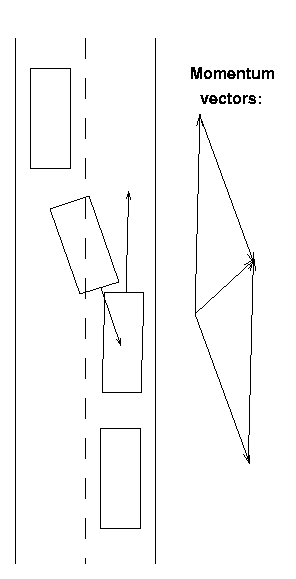
The figure shows the truck well into its turn and the Saturn just
beginning an evasive manueuver that's doomed to fail. The arrows are
velocity vectors of the vehicles. Multiplying the velocity vectors by
the mass ratio yields momentum vectors, their sum is shown in the
parallelogram to the right. The truck has turned some 19 degrees, the
Saturn only about 2. Adding the vectors gives us the momentum after the
collision. The parallelogram is the graphical way to add vectors.
Mathematically, it's useful to break the momentum vectors into vertical
horizontal components, add them, and convert back into a single vector.
This table shows the decomposition of the vehicle vectors (read down) and
the composition of the resultant (read up).
|
Saturn |
Truck |
Combined |
| velocity (MPH), angle |
35, 88 |
20, -71 |
5.5, 39 |
| Mass ratio |
1.0 |
1.4 |
2.4 |
| sideways speed, mv |
1.0, 1.0 |
6.6, 9.2 |
4.25, 10.2 |
| upward speed, mv |
35, 35 |
-19, -26.5 |
3.5, 8.5 |
So, all this says our forward speed went from 35 MPH to 3.5 MPH in an
instant, much like hitting a crushable barrier at 31.5 MPH, at least a
barrier that crushes like a pickup truck. We were also shoved sideways,
but with a lot smaller impulse. This seems to fit the facts pretty well.
The only item I would like to see is how the collision force varied
over time. Since the truck's bumper pretty much missed ours, the force
was fairly low as the headlight smashed and the hood buckled. When the truck's
bumper hit the engine, then the force must have soared to make up for
lost time and I imagine it peaked higher than it would have if the
bumpers did meet.
Contact Ric Werme or
return to his home page.
Last updated 2001 November 26.




